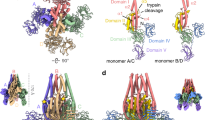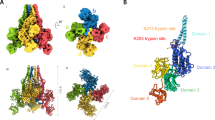Abstract
A member of the Bacillus-produced vegetative insecticidal proteins (VIPs) possesses high specificity against the major insect pest, corn rootworms, and belongs to a class of binary toxins and regulators of biological pathways distinct from classical A-B toxins. The 1.5 Å resolution crystal structure of the enzymatic ADP-ribosyltransferase component, VIP2, from Bacillus cereus reveals structurally homologous N- and C-terminal α/β domains likely representing the entire class of binary toxins and implying evolutionary relationships between families of ADP-ribosylating toxins. The crystal structure of the kinetically trapped VIP2–NAD complex identifies the NAD binding cleft within the C-terminal enzymatic domain and provides a structural basis for understanding the targeting and catalysis of the medically and environmentally important binary toxins. These structures furthermore provide specific experimental results to help resolve paradoxes regarding the specific mechanism of ADP-ribosylation of actin by implicating ground state destabilization and nicotinamide product sequestration as the major driving forces for catalysis.
This is a preview of subscription content, access via your institution
Access options
Subscribe to this journal
Receive 12 print issues and online access
$189.00 per year
only $15.75 per issue
Buy this article
- Purchase on Springer Link
- Instant access to full article PDF
Prices may be subject to local taxes which are calculated during checkout



Similar content being viewed by others
References
Warren, G.W. In Advances in insect control: the role of transgenic plants. (eds Carozzi, N.B. & Koziel, M.G.) 109–121 (Gunpowder Square, London, United Kingdom; 1997).
Nishimatsu, T. & Jackson, J. J. J. Econ. Entomol. 91, 410–418 (1998).
Madshus, I.H. & Stenmark, H. Curr. Top. Microbiol. Immunol. 175, 1–26 ( 1992).
Warren, G.W. et al. Novel pesticidal proteins and strains. World Intellectual Property Organization. Patent WO 96/10083 (1996 ).
Carlier, M.-F. Int. Rev. Cytol. 115, 139–170 (1989).
Aktories, K. et al. Nature 322, 390–392 (1986).
Stiles, B.G. & Wilkens, T.D. Infect. Immunol. 54 , 683–688 (1986).
Simpson, L.L., Stiles, B.G., Zepeda, H. & Wilkins, T.D. Infect. Immunol. 57, 255–261 ( 1989).
Popoff, M.R., Rubin, E.J., Gill, D.M. & Boquet, P. Infect. Immunol. 56, 2299–2306 ( 1988).
Sixma, T.K. et al. Nature 351, 371–377 (1991).
Bell, C.E. & Eisenberg, D. Biochemistry 36, 481–488 (1997).
Li, M., Dyda, F., Benhar, I., Pastan, I. & Davies, D.R. Proc. Natl. Acad. Sci. USA 93, 6902–6906 (1996).
Aktories, K., Weller, U. & Chhatwal, G.S. FEBS Lett. 212, 109– 113 (1987).
Barth, H., Hofmann, F., Olenik, C., Just, I. & Aktories, K. Infect. Immunol. 66, 1364– 1369 (1998).
Bull, H.G., Ferraz, J.P., Cordes, E.H., Ribbi, A. & Apitz–Castro, R. J. Biol. Chem. 253, 5186–5192 (1978).
Oppenheimer, N.J. Mol. Cell. Biochem. 138, 245–251 (1994).
Rising, K.A. & Schramm, V.L. J. Am. Chem. Soc. 119, 27–37 (1997).
Berti, P.J., Blanke, S.R. & Schramm, V.L. J. Am. Chem. Soc. 119, 12079 –12088 (1997).
Scheuring, J. & Schramm, V.L. Biochemistry 36, 8215–8223 (1997).
Scheuring, J. & Schramm, V.L. Biochemistry 36, 4526–4534 (1997).
Scheuring, J., Berti, P.J. & Schramm V.L. Biochemistry 37, 2748– 2758 (1998).
Banait, N.S. & Jencks, W.P. J. Am. Chem. Soc. 113 , 7958–7963 (1991).
Cherian, X.M., Van Arman, S.A. & Czarnik, A.W. J. Am. Chem. Soc. 112, 4490 –4498 (1990).
Bell, C.E. & Eisenberg, D. Biochemistry 35, 1137–1149 (1996).
Buckley, N., Handlon, A.L., Maltby, D., Burlingame, A.L. & Oppenheimer, N.J. J. Org. Chem. 59, 3609–3615 (1994).
Johnson, R.W., Marschner, T.M. & Oppenheimer, N.J. J. Am. Chem. Soc. 110, 2257 –2263 (1988).
Perelle, S., Domenighini, M. & Popoff, M.R. FEBS Lett. 395, 191– 194 (1996).
Barth, H., Preiss, J.C., Hofmann, F. & Aktories, K. J. Biol. Chem. 273, 29506–29511 (1998).
Bell, C.E., Yeates, T.O. & Eisenberg, D. Protein Sci. 6, 2084– 2096 (1997).
Berti, P.J. & Schramm, V.L. J. Am. Chem. Soc. 119, 12069–12078 (1997).
Otwinowski, Z. & Minor, W. Methods Enzymol. 276, 307–326 ( 1997).
Collaborative Computational Project, Number 4. Acta Crystallogr. D 50, 760– 763 (1994).
Jones, T.A., Zhou, J.-Y., Cowan, S.W. & Kjeldgaard, M. Acta Crystallogr. A 47, 110–119 ( 1991).
Brünger, A.T. et al. Acta Crystallogr. D 54, 905–921 (1998).
Laskowski, R.A., MacArthur, M.W., Moss, D.S. & Thornton, J.M. J. Appl. Crystallogr. 26, 283–291 (1993).
Navaza, J. Acta Crystallogr. A 50, 157–163 (1994).
Kraulis, P.J. J. Appl. Crystallogr. 24, 946–950 (1991).
Acknowledgements
We thank D.S. Daniels, J.L. Pellequer, T.P. Lo and C.M. Bruns for insightful discussions, and facilities at ALS and CHESS. Work on VIP2 was supported in part by the Skaggs Institute for Research and by Novartis Agribusiness Biotechnology Research Inc. C.D.P. was supported by a Howard Hughes Predoctoral Fellowship and J.A.T. by the NSF.
Author information
Authors and Affiliations
Corresponding author
Rights and permissions
About this article
Cite this article
Han, S., Craig, J., Putnam, C. et al. Evolution and mechanism from structures of an ADP-ribosylating toxin and NAD complex. Nat Struct Mol Biol 6, 932–936 (1999). https://doi.org/10.1038/13300
Received:
Accepted:
Issue Date:
DOI: https://doi.org/10.1038/13300
This article is cited by
-
Conditions for homogeneous preparation of stable monomeric and oligomeric forms of activated Vip3A toxin from Bacillus thuringiensis
European Biophysics Journal (2017)



